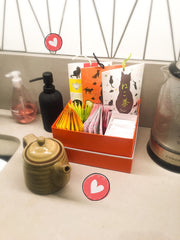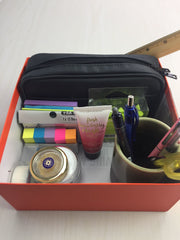Marie Kondo Your Life with Bokksu
Spring is just around the corner! Many of us here at Bokksu, and around the world, are launching headfirst into spring cleaning. Accumulating more and more items as the days go by, we find ourselves overwhelmed and wondering what to do with everything we bought or received as gifts. But with Marie Kondo in our hearts and Bokksu boxes in our hands, we’re ready to tackle tidying!
Many cultures around the world, including Japan, make time to clean at the end of the year. Japan calls its cleaning ritual osouji (大掃除 or “big cleanup”). Osouji is the act of purging clutter, grime, and dirt accumulated during the past year, allowing households to refresh and start anew. More than just cleaning, osouji takes place at the end of the year to symbolically start the new year free from past problems, burdens, and negativity. This gives us a chance to welcome the new year with a fresh, clean slate–physically and emotionally–during what is considered a time of renewal.
Spring is also considered a time for new beginnings, with March often considered optimal for cleaning thanks to warmer temperatures. The phrase “spring cleaning” gained popularity in English because spring is the perfect time to allow fresh air into the house without the threat of insects and breezes carrying dust and dirt outside of the house.
Coinciding with spring cleaning, many people have recently turned their attention to the “it” tidying expert Marie Kondo, an organizing guru from Japan, for decluttering advice. From her 2010 book, The Life-Changing Magic of Tidying Up: The Japanese Art of Decluttering and Organizing to the mega-popular Netflix series, “Tidying Up with Marie Kondo,” the cleaning craze has hit everyone!
The idea behind Kondo’s philosophy, otherwise known as the KonMari method, is simple: does this item spark joy? If not, rid yourself of the item. Of course, the whole process is a bit more hands-on than that but it’s still easy to digest:
- Separate your possessions into separate groups, attacking one pile at a time.
- Put your hands on everything that you own.
- Ask yourself, “does it spark joy?”
- If it does not spark joy, get rid of it. But don’t forget to thank the item first!
- Once only your most joy-giving belongings remain, put everything back in a place that is visible and easily accessible.
- Cleaning nirvana achieved!
While Kondo’s philosophy may originate from the Buddhist philosophy of dan-sha-ri (断捨離, refuse - throw away - separate), her, “Does it spark joy?” mantra is resonating with people worldwide due to its simplicity. The idea is not only easy to connect with, but also simple to execute. In your home, keep only that which gives you the most happiness and your life will become a clutter-free dream.
Our boxes actually can be used for way more than just holding delicious Japanese snacks. After eating all your tasty Bokksu snacks, you can actually repurpose the box instead of tossing it out. Reduce, reuse, recycle, am I right?
At Bokksu, we use our boxes to organize items in the office and even use them to store items at home! Bokksu’s boxes are a great foundation for organizing a variety of things like stationary, jewelry, and other knick-knacks. Here are some of our favorite ways we use our great boxes:




How do you use your Bokksu after all the snacks are gone? Tag #kondoyourbokksu and share!
Happy Kondo-ing!
Author Bio











